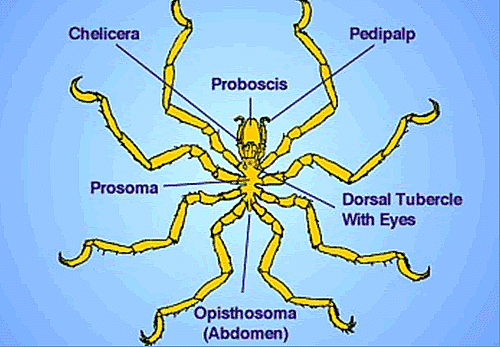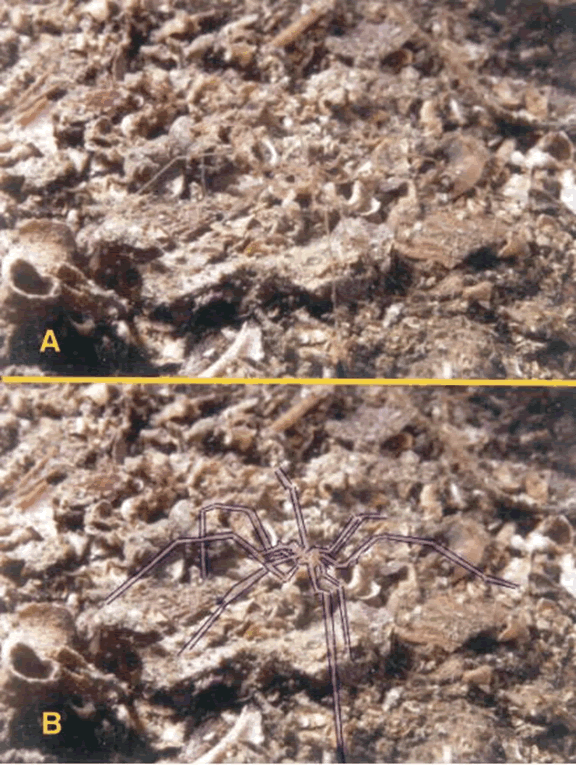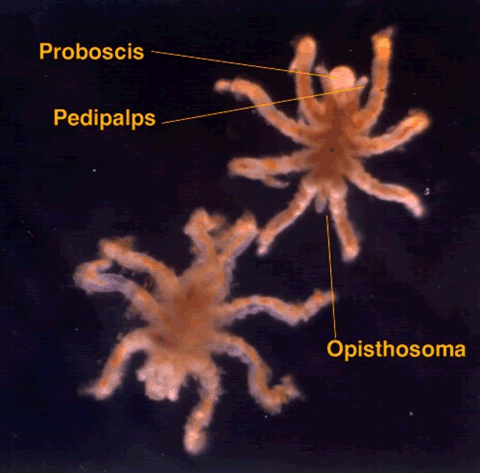|
True spiders, or animals
that would be placed in the group Arachnida within the huge
phylum Arthropoda, are not found in coral reefs or other submerged
marine environments, although some spiders are active predators
in intertidal habitats around the world. There is, however,
one group of spider-like animals that is found in most marine
environments, and that is the sub-phylum or class Pycnogonida,
or the so-called "sea spiders." These are some of
the more peculiar beasts that we can get in our aquaria, and
most of them are probably unwelcome guests.
Arthropods are animals with a jointed exoskeleton
made mostly of protein, but with a bit of an odd structural
material called chitin, and in the case of many marine representatives,
more than a smidgen of calcium carbonate. This huge array
of animals includes among its representatives the insects
in all their buzzing, biting, and annoying glory. As insects
make up the majority of scientifically-described animals,
the phylum Arthropoda is considered to be the largest group
of animals. Fortunately, there are very few true marine insects,
and the marine diversity of the group is correspondingly less.
Most marine arthropods are crustaceans, which are animals
such as crabs, shrimps, and the ubiquitous "pods"
found in marine aquaria. Crustaceans are characterized by
having two pairs of antennae or "sensory whiskers"
on their head, as well as jaws to mash their food.
A few other arthropods, having neither
antennae nor jaws, are found in the marine realm. As they
lack some of the definitive crustacean characteristics they,
therefore, cannot be crustaceans. These animals are called
chelicerates (pronounced "KEL - iss - er - ates (preferred)
or ka-LISS-er-ates (acceptable)). Terrestrial chelicerates
include the scorpions, spiders, mites and ticks, as well as
some other rather odd animals. Marine chelicerates include
horseshoe crabs, mites, and pycnogonids.
All chelicerates, terrestrial and marine,
share a few common characteristics. First, they are arthropods,
so they have a jointed, external covering that doubles as
both a protective armor and as a skeleton. Internally, they
have a long tubular heart, and a circulatory system that is
largely without vessels. Unlike us, and other vertebrates,
their central nervous system is ventral, running down the
bottom midline of the animal, rather than dorsally along the
back. Generally, their blood pigment is hemocyanin and based
on copper rather the familiar hemoglobin of vertebrates. When
their blood is oxygenated it is a robin's egg blue in color;
when deoxygenated, it is colorless.
Follow this link for pictures of the blue
blood of chelicerates: LINK
Chelicerates have some specific and particular
characters. They lack both antennae, and jaws. The latter
characteristic is pretty important, as it means they must
eat prey that is either liquid or made of very small particles.
They often have a pair of pincer-like appendages, called chelicerae,
(singular = chelicera) which appear to be similar to the claws
of crabs. However, these appendages arise from the head and
are structurally and embryologically different than the claws
of crabs, which are derived from thoracic appendages. In fact,
the structure of the chelicerae is so different and distinctive
that it is what gives the group its name.
All chelicerates have two major body regions,
each of which is composed of several fused embryological segments
or regions. In the adult, however, these components may be
effectively impossible to distinguish. The front region is
called the fore-body or "prosoma," and consists
of, what in other arthropods, would be the segments of the
head and thorax. It bears the legs and the other appendages,
the chelicerae and pedipalps. The long, often leg-like, pedipalps
are considered to be sensory, but in some chelicerates they
are quite large and they seem to function as aids in locomotion.
. Generally, the pedipalps are held up in front of the chelicerate
as it moves, waving around and touching the substrate as needed
to "taste the world" or "see which way the
wind blows." The back region, called the abdomen, after-body
or "opisthosoma," often lacks appendages (see Figure
1). If appendages are present on the opisthosoma, they are
reduced in size and are often involved in respiratory functions.
Most chelicerates such as horseshoe crabs, spiders, mites
and scorpions have four pairs of walking legs; other appendages
are one pair each of chelicerae and pedipalps.
There are a lot of marine chelicerates,
but the majority of these are small mites. Although occasionally
found in aquaria, they are generally overlooked. The largest
living chelicerates are marine animals called Xiphosurans,
or horseshoe crabs. There are four living species of this
group, which is also called the Merostomata. Three species
of horseshoe crabs are found in Southeast or Eastern Asian
waters, and one species, Limulus polyphemus, is found
off the eastern shore of North America and in the Caribbean.
In some very ancient seas, a group of animals quite similar
to horseshoe crabs and modern scorpions, called Eurypterids,
were found. A few species reached lengths in excess of ten
feet long, and were quite massive. Referred to as "water
scorpions" they were the largest arthropods in the Earth's
long history. Eurypterids were predatory and were likely the
largest predators of their day.
The Pycnogonida or Sea Spiders
There are probably somewhere around 1000
scientifically described species of pycnogonids, or sea spiders.
There are undoubtedly far more than that, and the majority
of these are likely to be found on coral reefs eating corals,
sea anemones, hydroids, soft corals and other soft-bodied
animals.
Follow this link to sea a beautiful sea
spider that eats various types of sea slugs: http://www.seaslugforum.net/pycnogon.htm
Pycnogonids are found in all seas but,
with few exceptions, are seldom common animals. They are typically
small animals, from about 0.04 inches to few inches across
the leg span. However, there are some giant forms, with a
leg span of a couple of feet. The larger animals are generally
from the deep sea or polar areas and, in fact, may often be
quite abundant and found in large aggregations. If you have
real or incipient arachnophobia, photos of thousands of these
large "spiders" crawling across the ocean bottom
can make your skin crawl.
To see some of the larger pycnogonids, follow these links:
LINK
1, LINK
2.
The name "pycnogonid" is derived
from the Greek "pyknos" meaning "strong
or compact" and "gonia" meaning "a
joint, knee, or angled," and refers to the fact that
these animals look like a collection of legs and/or angles
with no real body. The body is reduced to a thin tubular section
in between what are, often, quite long legs. Because of their
very odd shape, pycnogonids have often been placed in a group
of their own and are considered to be quite distinct from
the other chelicerates. Modern genetic and morphological analyses,
however, places them firmly in the chelicerates. Because of
this rather long history of separation, a jargon terminology
specific to the group has been applied to them. As in all
chelicerates, pycnogonids possess chelicerae, here called
chelifores, and pedipalps, simply called palps. I have reverted
to the more general terms of chelicera and pedipalps in the
illustrations for this column. Either the palps or chelifores
may be absent in various species. Unlike the situation found
in most groups of arthropods, the number of body segments
and legs can vary from species to species, although they are
consistent within each species. However, there are pycnogonids
with 4, 5, or 6 pairs of legs. Additionally, the males have
an extra pair of smaller "legs" that they use to
carry around the eggs laid by the females.
There are two distinct types of pycnogonids:
those with short legs that are often predatory or ectoparasitic
on animals such as hydroids and corals, and those with long
legs which are often predatory on other animals. The short-legged
animals are often quite tiny, while the long-legged animals
may be quite large (see Figures 2, 3).
 |
|
Figure
1. A diagram of a generalized pycnogonid showing
some of the body features. Modified from Kozloff, 1990.
|
 |
|
Figure
2. Even relatively large pycnogonids may be quite
difficult to see, depending upon their position on the
background. In A, above, a pycnogonid that is
about 1.5 inches across the leg span fills much of the
picture. In B, below, I have outlined the legs
and body in purple. This ability to blend into a background,
coupled with exceptionally slow movements, may make
these animals essentially invisible to potential predators.
|
Pycnogonids have a poor fossil record,
but a few that have been found are truly ancient, indicating
they have been around for hundreds of millions of years, see
here: http://www.ucmp.berkeley.edu/.../mystery16.html
Follow this link to see a scanning electron
micrograph of the body structures: http://www.anst.uu.se/joakerik/bilder/ap1.jpg
In many pycnogonids the body is exceedingly
narrow, about the width of one of the legs, and the posterior
body region, the opisthosoma, is reduced to a tiny nubbin.
At the front end of the animal is a large suctorial proboscis;
a tube used in piercing and sucking up food. The proboscis,
in most species, is lined with ridges of hardened cuticle
and is quite muscular. Such a structure is quite capable of
masticating food, so even though they lack jaws they may chew
their food. Downstream of the proboscis, the gut forms a short
esophagus and then passes into the main part of the gut, which
occupies much of the body. The body is so thin that much of
the digestive and absorptive glandular tissues of the gut
are found out in the legs, an arrangement seen in no other
type of arthropod. Their digestive process may best be described
by one word - STRANGE. The food slurry
is shunted to glandular lobes of the midgut. These lobes extend
out into the legs where they are bathed by blood in a body
cavity called the hemocoel. The distribution of digested nutrients
is very poorly known in pycnogonids. It has been stated that
the cells lining these glandular lobes absorb food or actively
ingest food, and then break free and "drift" off
into blood flowing throughout the hemocoel. These "drifter"
cells supposedly attach elsewhere in the body some distance
from the gut. After they have done so, the cells now adjacent
to the attached drifters, receive digested food from these
"drifters." The blood is moved through the body
by the action of a long tubular heart, and by generalized
body movements. Although this may seem somewhat haphazard,
it works well to distribute the "drifter" cells
as well as other corpuscles. Nonetheless, this, to say the
least, is a bizarre way to distribute nourishment, and it
is by no means certain that this is actually how it is done.
Digestion and food distribution in these beasties needs to
be studied in much greater detail.
As befitting their thin nature, which creates
a lot of potential surface area for gas exchange, they have
no specialized organs for respiration. They also have no specialized
organs for the production of nitrogenous wastes. Presumably
both respiration and excretion take place across the body
wall through the exoskeleton. If so, this is a decidedly unusual
arrangement for any arthropod. On the other hand, these animals
are poorly known, and specialized microscopic excretory structures
may well be found with more rigorous and thorough examination.
As with other aspects of their biology,
reproduction is relatively poorly known. The gonads extend
out into the legs. Eggs or spermatozoa are released from the
bases of some of the legs. Unlike most arthropods, fertilization
appears to be external, and the males brood the eggs on thin,
small, appendages called "ovigerous legs." After
embryonic development, an odd parasitic larva is formed. This
larva, called "the protonymphon larva," has a suctorial
mouth, and two pairs of appendages. It makes its way to a
juvenile host where it eats host tissues and fluids, and undergoes
several molts. Sometimes these larvae even live internally
in the host. Finally, they emerge from the juvenile host as
the predatory adults. The juvenile host may or may not be
the same as the adult host. For example, some pycnogonids
whose adults are predatory on hydroids spend their larval
period in the gills of clams.
For much information, great photos and
descriptions of feeding and locomotion, including animations
in pycnogonids, see this site: http://www.ualberta.ca/~jmg1/research.html
Aquarium Occurrences:
Pycnogonids have been reported and sent
to me for identification sporadically over the last few years.
Small, but relatively long-legged, animals have been recorded
from a couple of aquarists in California. These small animals,
often less than one-quarter inch across, appear to be predatory
or parasitic on various corals and are quite capable of killing
the corals. A type of short-legged pycnogonid has been found
that is, of all things, a predator on that bane of reef aquarists,
Aiptasia. Unfortunately, attempts to culture this predator
were unsuccessful (see Figure 3).
 |
|
Figure
3. Two individuals of a short-legged form of pycnogonid
found parasitizing a large clonal aggregation of Aiptasia.
Unfortunately, they were not able to be cultured. The
animals are covered in anemone mucus, and I could not
clean it off them for a clear photograph.
|
Sea spider predation or parasitism is a
potential threat to all corals, soft corals, and sea anemones
that are kept in aquaria. If an aquarium system gets infected,
just how easy it is to control the pest species will really
depend on the type of pycnogonid that is present. The large
forms are typically slow, and readily apparent, and may be
easily removed from aquaria. The small forms, on the other
hand, may be quite difficult to see, as they may be as small,
or smaller, than the polyps of small-mouthed corals. Additionally,
they may live under the coral mucus layer, and this would
further obscure them. They do not appear to be easily removed
by "dips," poisons, or potential predators. Frankly,
if they are found on corals in any tank, the best option would
likely be to remove the coral from the tank, and simply dispose
of it.
|

